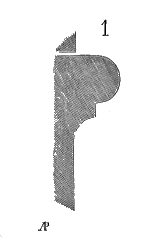Astragal
Astragal refers to a concept or object that can be understood in various contexts, primarily in architecture, anatomy, and gaming. This article will explore these different aspects to provide a comprehensive understanding of the term.
Astragal in Architecture[edit | edit source]
In architecture, an astragal is a small moulding or trim attached to the meeting stiles of a pair of double doors or windows to prevent swinging through, cover the gap for privacy, or add a decorative element. Typically, it is a rounded, semi-circular profile that can be plain or ornamented, serving both functional and aesthetic purposes. The astragal helps in sealing the gap between the doors to prevent light, sound, or air from passing through, enhancing the doors' performance in terms of insulation and privacy.
Astragal in Anatomy[edit | edit source]
In anatomy, the term astragal refers to the talus bone of the ankle. This bone plays a crucial role in the foot's structure, acting as a critical connector between the leg and the foot, allowing for a range of movements. The astragalus is situated between the fibula, tibia, and the bones of the lower foot, facilitating motion and weight distribution during walking or running. Its unique shape and articulations with surrounding bones make it essential for the foot's stability and flexibility.
Astragal in Gaming[edit | edit source]
In the context of gaming and historical divination, an astragal refers to a die or knucklebone used in games of chance or for divination purposes. Historically, astragals were made from the ankle bones of sheep, goats, or other animals and could have different shapes and markings, indicating their value or outcome in the game. These objects have been used in various cultures over millennia, serving both as tools for entertainment and as means for making decisions or predicting the future.
See Also[edit | edit source]
This article is a architecture-related stub. You can help WikiMD by expanding it!
This video game-related article is a stub. You can help WikiMD by expanding it.
Transform your life with W8MD's budget GLP1 injections from $125
W8MD offers a medical weight loss program NYC and a clinic to lose weight in Philadelphia. Our W8MD's physician supervised medical weight loss centers in NYC provides expert medical guidance, and offers telemedicine options for convenience.
Why choose W8MD?
- Comprehensive care with FDA-approved weight loss medications including:
- loss injections in NYC both generic and brand names:
- weight loss medications including Phentermine, Qsymia, Diethylpropion etc.
- Accept most insurances for visits or discounted self pay cost.
- Generic weight loss injections starting from just $125.00 for the starting dose
- In person weight loss NYC and telemedicine medical weight loss options in New York city available
- Budget GLP1 weight loss injections in NYC starting from $125.00 biweekly with insurance!
Book Your Appointment
Start your NYC weight loss journey today at our NYC medical weight loss, and Philadelphia medical weight loss Call (718)946-5500 for NY and 215 676 2334 for PA
Search WikiMD
Ad.Tired of being Overweight? Try W8MD's NYC physician weight loss.
Semaglutide (Ozempic / Wegovy and Tirzepatide (Mounjaro / Zepbound) available. Call 718 946 5500.
Advertise on WikiMD
|
WikiMD's Wellness Encyclopedia |
| Let Food Be Thy Medicine Medicine Thy Food - Hippocrates |
Translate this page: - East Asian
中文,
日本,
한국어,
South Asian
हिन्दी,
தமிழ்,
తెలుగు,
Urdu,
ಕನ್ನಡ,
Southeast Asian
Indonesian,
Vietnamese,
Thai,
မြန်မာဘာသာ,
বাংলা
European
español,
Deutsch,
français,
Greek,
português do Brasil,
polski,
română,
русский,
Nederlands,
norsk,
svenska,
suomi,
Italian
Middle Eastern & African
عربى,
Turkish,
Persian,
Hebrew,
Afrikaans,
isiZulu,
Kiswahili,
Other
Bulgarian,
Hungarian,
Czech,
Swedish,
മലയാളം,
मराठी,
ਪੰਜਾਬੀ,
ગુજરાતી,
Portuguese,
Ukrainian
Medical Disclaimer: WikiMD is not a substitute for professional medical advice. The information on WikiMD is provided as an information resource only, may be incorrect, outdated or misleading, and is not to be used or relied on for any diagnostic or treatment purposes. Please consult your health care provider before making any healthcare decisions or for guidance about a specific medical condition. WikiMD expressly disclaims responsibility, and shall have no liability, for any damages, loss, injury, or liability whatsoever suffered as a result of your reliance on the information contained in this site. By visiting this site you agree to the foregoing terms and conditions, which may from time to time be changed or supplemented by WikiMD. If you do not agree to the foregoing terms and conditions, you should not enter or use this site. See full disclaimer.
Credits:Most images are courtesy of Wikimedia commons, and templates, categories Wikipedia, licensed under CC BY SA or similar.
Contributors: Prab R. Tumpati, MD




